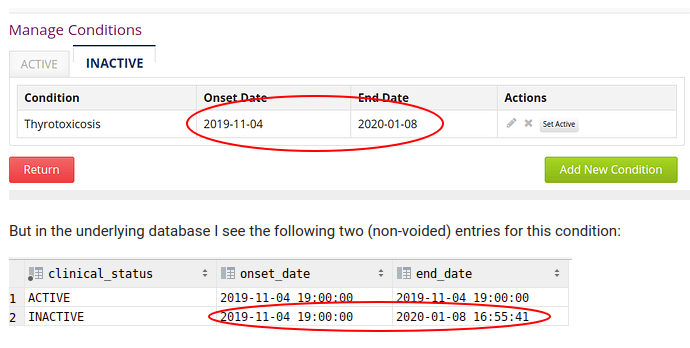Hello all… first off, I wanted to thank everyone who has worked on the Condition List functionality within the Reference App for all their hard work. This is an oft-requested feature that many are looking forward to having available.
I do think we are getting close to having a stable product to release, but unfortunately testing today I did notice a few more bugs, which I have ticketed here. One, unfortunately, is related to pesky timezone issues.
https://issues.openmrs.org/browse/RA-1677
https://issues.openmrs.org/browse/RA-1678
Beyond, I’ve noticed one other thing that I think is a bug, but I want to clarify what the exact expected behavior and modeling is…
A Condition has a “clinicalStatus”, which can be “Active”, “Inactive” and “History_Of”, as well as an onset date and end date, and the Condition List UI allows the user to switch a status between “active” and “inactive”.
Let’s say I have an existing condition “Thyrotoxicosis” for a patient, with an onset date of “2019-11-04”:
Then I click the “inactive” link and mark that condition as inactive:
The updated “Inactive” list looks like this:
But in the underlying database I see the following two (non-voided) entries for this condition:

This seems wrong, but I want to make sure that the expected result would be:
status: ACTIVE, onsetDate: 2019-11-04, endDate: 2020-01-08 16:55:41
status: INACTIVE, onsetDate: 2020-01-08 16:55:4, endDate:
Am I correct? It does feel kind of weird to have an “onset date” for an inactive condition.
Also, I assume the 90% use case for this widget is to simply show the active condition list for a patient… thoughts on if (and how) we could simplify the UI to just allow the adding and removing of conditions (without having to specify dates) so we could get something simple working without having to worry about all the nuances of dates?
fyi @mozzy @burke @jteich @mseaton @ball
Thanks and take care,
Mark



 )
)